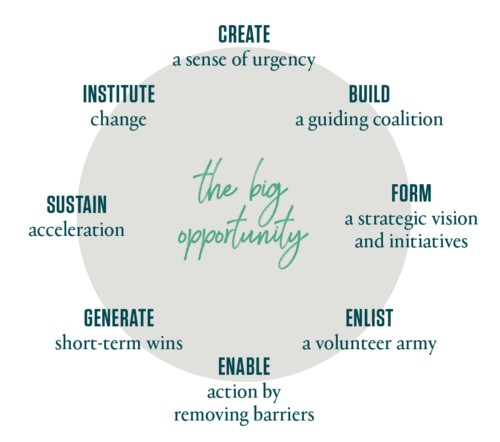An Introduction to Kotter’s 8-Step Change Model
When considering change management, John Kotter’s 8-Step Change Model is one of the most influential frameworks to use in reports or courseworks. Currently a professor at the Harvard Business School, John Kotter originally created this framework to respond to the need for new methods of formalising change processes (Kotter, 1995). The 8-Step theory provides businesses with a structured strategy of ensuring the success of their change processes, explaining the popularity of this framework. To help you use Kotter’s 8-Step Model in academic assignments, we have prepared a short guide focusing on the key elements, benefits and limitations of this paradigm.
The Stages of Kotter’s 8-Step Change Model
The following figure graphically summarises the change cycle proposed by Kotter.
Figure 1: Kotter's 8-Step Change Model
Source: KotterInc (2020, n.p.)
Each stage in the model
Creating a Sense of Urgency
This procedure typically involves distributing communications among employees and stakeholders highlighting why exactly current processes require change. For example, following the failure of Microsoft Zune, Satya Nadella, the newly appointed CEO of Microsoft, sent a series of internal press releases clearly indicating a need for transformation within the business (Hempel, 2015).
Building a Coalition
To build a coalition, change managers need to convince formal and informal leaders within a company that the proposed change project is ultimately beneficial. In a hypothetical company, this would involve identifying such key personnel and conducting joint meetings to discuss the change process and ensure that other leaders are committed to the change programme (Canterino et al., 2020).
Forming a Strategic Vision
A successful change project needs to rely on a narrowly-defined change vision to motivate others to commit to organisational transformation. In the Microsoft example above, Satya Nadella established that the mission of Microsoft was to provide services helping people to be productive; this contrasted with Microsoft’s previous commitment to devices and in-house services (Hempel, 2015). The vision statement has to apply to all employees starting from factory workers and ending with senior managers.
Enlisting a Volunteer Army
This stage of Kotter’s model involves explicitly recruiting employees to be ambassadors for change. For instance, a company could create teams consisting of elected employee representatives (van Assen, 2019). These groups of formal leaders would collect feedback from other employees and monitor their subordinates’ performance against the established change objectives (e.g. the implementation of 3D printing for improving manufacturing performance).
Enabling Action by Removing Barriers
During this stage of the change process, leaders are required to identify and eliminate inefficient processes and elements of organisational structure. In a well-known example of organisational change, when appointed as an executive at British Airways, eliminated unprofitable routes and cut the total size of the firm’s workforce by more than 20% (Balmer et al., 2009). This led to British Airways avoiding bankruptcy.
Generating Short-Term Wins
To generate short-term wins, managers need to produce interim reports and reviews highlighting the company’s current performance measured against the established change objectives. To achieve this aim, an organisation could use an electronic dashboard (e.g. Monday or Atlassian) to automatically track change progress and allow for instant electronic communications between managers and regular employees.
Sustaining Acceleration
To preserve acceleration, managers are required to create new positions of power and procedures that would make change self-sustainable. Continuing the example of Microsoft, Satya Nadella sustained acceleration by creating an office of a chief executive of experiences to monitor how the different products of Microsoft such as Xbox and Windows interacted with each other and third-party apps (Hempel, 2015).
Instituting Change
At the final stage of Kotter’s model, leaders need to ensure that the new processes become the organisational norm. This can be done by creating new performance objectives for the employees to follow or issuing a formal code of conduct. Another example is conducting regular audits to monitor compliance with the new strategic vision.
Using Kotter’s Model in Academic Assignments
When Should I Use Kotter’s Model?
The 8-Step Model is highly relevant to reports and essays on project management, change management, leadership and organisational behaviour. If you choose to use this framework, however, remember that not all change necessarily follows a rigid plan. Leave at least some of the allocated word count for discussing alternate approaches such as Lewin’s change management model. Kotter’s framework also ignores how change processes could be affected by political or social factors. If you have the opportunity, you should definitely allocate a paragraph to discussing such issues.
How Should I Present My Findings?
To analyse change processes using Kotter’s framework, you could always follow the structure in the previous section of our guide by using sub-heading to denote each stage of the 8-Step Model. If your word count is limited, however, using a figure or a table is also a valid option as these are typically exempted from such requirements. For each point, try to include at least one obstacle or limitation to meet the criteria of rigorous critical analysis. For instance, an international organisation will struggle to sustain acceleration if this firm lacks a uniform approach to measuring performance across all of its subsidiaries.
Kotter’s Model and Our Services
Our professional essay and report writing services will not only apply Kotter’s model to your organisation of choice but will also mention the benefits and limitations of this framework. When using Kotter’s theory, we will go through each stage of the 8-step strategy and provide detailed practical recommendations to whatever companies you specify in your order. Our writers will also compare Kotter’s paradigm to Lewin’s change management model and choose the most suitable path of action for real-life and hypothetical businesses. If you need to avoid a word count penalty, we will create unique tables and figures presenting the findings in a concise and structured manner. Our services will meet the criteria of a critical and analytical discussion by explicating what companies lack in comparison to Kotter’s recommendations and what opportunities for change should be exploited in future development. Don’t hesitate to contact us if you are stuck with running a strategic change analysis.
References
Balmer, J., Stuart, H. and Greyser, S. (2009) “Aligning identity and strategy: Corporate branding at British Airways in the late 20th century”, California Management Review, 51 (3), pp. 6-23.
Canterino, F., Cirella, S., Piccoli, B. and Shani, A. (2020) “Leadership and change mobilization: The mediating role of distributed leadership”, Journal of Business Research, 108 (1), pp. 42-51.
Hempel, J. (2015) “Microsoft in the Age of Satya Nadella”, [online] Available at: https://www.wired.com/2015/01/microsoft-nadella/ [Accessed on 20 May 2020].
Kotter, J. (1995) Leading Change, Boston: Harvard Business Review Press.
KotterInc (2020) “8-Step Process”, [online] Available at: https://www.kotterinc.com/8-steps-process-for-leading-change/ [Accessed on 20 May 2020].
van Assen, M. (2019) “Empowering leadership and contextual ambidexterity–The mediating role of committed leadership for continuous improvement”, European Management Journal, to be published.


